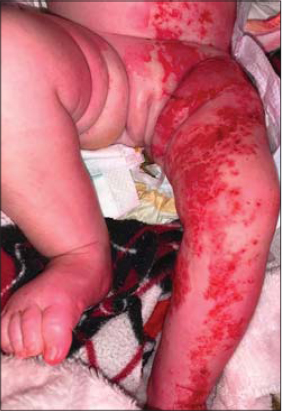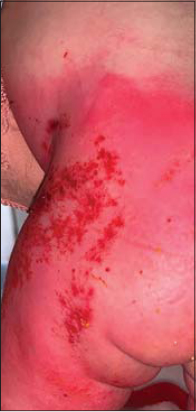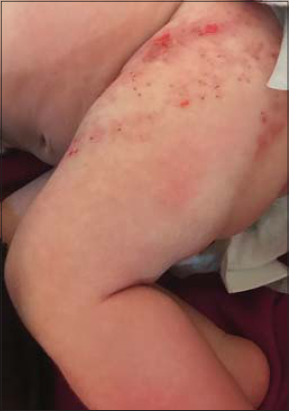Incontinentia pigmenti: A rare genodermatosis
Hind Palamino , Siham Belmourida, Mariame Meziane, Nadia Ismaili, Leila Benzekri, Karima Senouci
, Siham Belmourida, Mariame Meziane, Nadia Ismaili, Leila Benzekri, Karima Senouci
Dermatology-Venereology Department, CHU Ibn Sina, Rabat, Morroco
Corresponding author: Hind Palamino, MD
Submission: 24.08.2020; Acceptance: 30.12.2020
DOI: 10.7241/ourd.2021e.12
Cite this article: Palamino H, Belmourida S, Meziane M, Ismaili N, Benzekri L, Senouci K. Incontinentia pigmenti: a rare genodermatosis. Our Dermatol Online. 2021;12(e):e12.
Citation tools:
Copyright information
© Our Dermatology Online 2021. No commercial re-use. See rights and permissions. Published by Our Dermatology Online.
Infant of 6 months, female, referred by her pediatrician for skin lesions evolving for 2 weeks, with concept of a similar episode since birth evolving by relapses remission according to the mother, the questioning does not find a similar case in the family. the clinical examination objectified vesiculo-pustular lesions with some post-bullous erosions with unilateral crusts of linear localization occurring ines affecting the left lower limbs, on the buttocks and on the upper limb (Figs. 1 – 5). The examination of the mucous membranes and integuments was normal and the rest of the examination did not show any dental malformation or neurological damage. the ophthalmologic examination was normal, Biological assessment was within the standards. We retained the diagnosis of Incontinentia pigmenti (Stage I).
Incontinentia pigmenti is a rare genodermatosis with dominant transmission linked to X, it manifests in newborns, often female by a vesiculo-pustular rash, predominantly acral, with linear arrangement, along the Blascko line, it is a multisystem disease which also affects the teeth, eyes and nervous system, early diagnosis is necessary in order to detect and manage complications [1].
Consent
The examination of the patient was conducted according to the principles of the Declaration of Helsinki.
The authors certify that they have obtained all appropriate patient consent forms, in which the patients gave their consent for images and other clinical information to be included in the journal. The patients understand that their names and initials will not be published and due effort will be made to conceal their identity, but that anonymity cannot be guaranteed.
REFERENCES
1. MinićS, Trpinac D, ObradovićM. Incontinentia pigmenti diagnostic criteria update. Clin Genet. 2014;85:536-42.
Notes
Source of Support: Nil,
Conflict of Interest: None declared.
Request permissions
If you wish to reuse any or all of this article please use the e-mail (brzezoo77@yahoo.com) to contact with publisher.
| Related Articles | Search Authors in |
|
 http://orcid.org/0000-0002-2795-9161 http://orcid.org/0000-0002-2795-9161 |








Comments are closed.